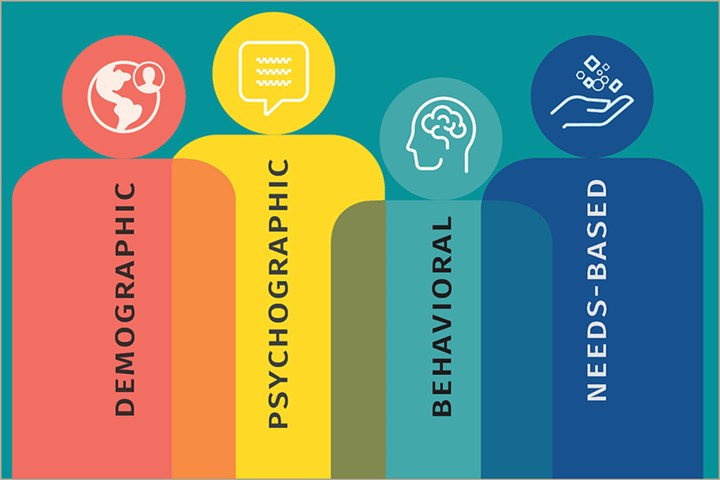How Best-Practice Segmentation Delivers Faster and More Profitable Growth
There are many approaches to customer and market segmentation. The best method will depend on the business and its goals. This article explores 4 approaches to segmentation, 5 steps to create a successful customer segmentation model, 3 key data considerations, and 5 segmentation best practices. Note: Anyone in the Gardner community who uses GW17Lucky will receive a 17% discount on The Market and Customer Segmentation Workbook. It will only be good for this workbook and will be effective from February 20th through St. Patrick’s Day, March 17th, midnight central time. It will automatically expire at that time.
By Laura Patterson, Founder and President
VisionEdge Marketing Inc.
Segmentation pays off. It provides a competitive edge through increased customer-centricity, which in turn drives customer acquisition, loyalty, lifetime value, and advocacy.
Segmentation uncovers niches that are not well-served. It identifies which segments are the most available and that have the opportunity to provide the highest revenue and return on investment.
As in any strategy, choosing which segments not to enter is at least as important as choosing which to enter. Successful segmentation results in accelerated, and more profitable, growth.
A key part of any segmentation strategy is to consider your target market’s unique characteristics, values, behaviors, and needs. By effectively implementing customer and market segmentation, businesses of all sizes can create highly targeted and engaging marketing campaigns, tailor their products or services to specific customers, and allocate resources more efficiently.
“If you are not thinking segments, you’re not thinking.”
– Theodore Levitt, professor at the Harvard Business School, author of Marketing Imagination.
The value of customer segmentation is like having a tailor make a custom-fit suit for a client. Just as a tailor takes precise measurements and considers the client's personal style and needs to create a unique garment, a business uses customer segmentation to create personalized experiences and solutions for their target market.
This article explores 4 approaches to segmentation, 5 steps to create a successful customer segmentation model, 3 key data considerations, and 5 segmentation best practices.
4 Approaches to Segmentation and Examples of How to Use Them

There are many approaches to customer and market segmentation. The best method will depend on the business and its goals. Here are the four most often-used types of market segmentation, including examples of how each might be used in the manufacturing industry.
- Demographic: This involves dividing the market based on characteristics such as age, gender, income, education level, and geographic location. For example, a tools manufacturing company targeting new homeowners might segment its market based on age (28-36), income ($50,000-$150,000 household income), and geographic location (suburban areas near major cities).
- Psychographic: This approach looks at customers' values, attitudes, interests, and lifestyles. A food manufacturer targeting vegan consumers might segment their market based on values (concern for animal welfare, environmental sustainability), attitudes (health-conscious, environmentally conscious), and lifestyle (vegan or plant-based diet).
- Behavioral: This method divides the market based on customers' actions or behaviors, such as their purchase history, frequency of use, and brand loyalty. For example, a semiconductor manufacturing company targeting enterprise customers might segment their market based on purchasing behavior (frequent buyers of semiconductors, companies who make products with high electronic components), usage patterns (customers who frequently need to upgrade their products to remain competitive), and loyalty (customers with long-term contracts or high retention rates).
- Needs-based: This approach focuses on customers' needs and pain points, and end uses, then divides the market based on the specific solutions or benefits they are seeking. A game manufacturing company targeting individual gamers might segment its market based on specific needs (affordability, user experience, flexible rewards, flexible playing options), and offer tailored gaming packages that address these needs.
By considering the unique characteristics, values, behaviors, and needs of your target market, businesses can create targeted marketing campaigns and tailor their products or services to specific customer segments.
If you’re wondering whether you can combine approaches, the answer is yes. Combining methods adds more layers and insights, it also adds complexity.
5 Steps to Create a Successful Customer Segmentation Model

There are five major steps in creating a successful segmentation model.
- Define your goals: Clearly define what you hope to achieve through your segmentation efforts. This will help you to select the right approach and ensure that you are focusing on the right segments. As part of this step establish your segmentation criteria, i.e., what will constitute a viable segment. We establish criteria around two dimensions: opportunity and accessibility.
- Gather and analyze data: Data is at the core of any model, including segmentation. It is such a crucial part of creating any model that we’ve added a sidebar on this topic. To create a segmentation model, you will need to collect as much data as possible about your current and potential customers, including demographic information such as size/revenue, industry, location(s), technology platforms, products/services offered, etc., along with information about their participation in the ecosystem, such as their suppliers, association memberships, their customers, connections to your current customers, and any information related to purchase history for products from you or your competitors; market and economic trend data, and any data you’ve collected regarding customer preferences, such as channel and touchpoints. You will use this data to build your model so that you can make data-driven decisions about your target market and help determine both your ability to access a segment and whether the segment is worth pursuing.
- Create your segmentation model: Use the insights and data you have gathered to create a segmentation model that outlines the characteristics, needs, and behaviors of each segment. Your model should be based on concrete data and criteria. The best segmentation model for your business will depend on your goals, resources, and target market. By carefully evaluating these factors and using data-driven insights, you can create a segmentation model that helps the business effectively reach and serve its target market. Review and update your model regularly. We live in a dynamic environment and so do your prospects and customers. There are several types of segmentation models. Some of the most commonly used types are:
-
- Single-segment concentration: This model focuses on a single, well-defined segment. The goal is to be the best or only provider for that segment.
- Selective specialization: This model focuses on a few specific segments. The goal is to be the best provider for those segments.
- Full market coverage: The goal of this model is to serve all segments of the market and offer a range of products or services to meet the needs of each segment.
- Niche market: This model focuses on a very specific, narrow segment of the market. The goal is to be the best provider for that niche.
- Mass customization: The goal of this model is to offer customized products or services to individual customers or small groups, while still maintaining economies of scale.
-
- Identify key segments: Evaluate potential and existing market and/or customer segments using the data and your criteria. Optimal segments are those that meet your criteria best.
- Validate your segments and model: We strongly encourage testing your segments to ensure that they are accurate and relevant. This may involve conducting market research or using A/B testing to see how different segments respond to different marketing messages or offers.
5 Segmentation Best Practices and Tips for Any Business
As you embark on segmentation, we recommend keeping these five best practices in mind.

- Clarity and Specificity Matter. It's important to be specific and deliberate in your targeting to ensure that your marketing, product, sales, and customer success efforts are effective and efficient. Consider the characteristics, needs, and behaviors of your ideal customer, and use this information to create detailed buyer personas.
- Did we say Data? Collect and analyze data. Gather as much data as possible and use this data to inform your segmentation strategy and make data-driven decisions about your target market.
- Test and iterate: Be willing to experiment with different segments and targeting approaches. Use A/B testing to see what works and what doesn't, and be prepared to adjust your strategy as needed.
- Communicate customer value: All the best segmentation in the world is for naught if you don’t have something your prospects and customers want and need. Clearly communicate your value proposition, positioning, and competitive differentiation and ensure these are tightly linked to the specific target segments’ problems and/or opportunities. Use language and messaging that resonates with your target market, and be sure to highlight the benefits and solutions that are most relevant to them.
- Personalize the customer experience: Once you've identified and targeted specific segments, use this information to create a personalized customer experience. This could include tailored marketing communications, customized product recommendations, and personalized support.
Wrap Up
Customers usually have multiple choices in products or services to meet their needs. There are competitors. Fickle customers present a challenge for brands that want to connect with them and engender their loyalty and advocacy. Winning customers over requires targeted and valuable communication, which can only be achieved by understanding the market category dynamics, and their wants and needs.
This takes effective segmentation.
Why is well-researched, criteria-based, segmentation identification and sizing so crucial? It:
- Improves targeting, increases revenue, accelerates growth, and provides a competitive edge in existing, as well as, new markets.
- Provides important input for persona development and Customer Journey Mapping, to improve customer experience and demand generation efforts.
- Enables you to precisely tailor and engage prospective and existing customers to your solution and distinct value proposition, its channels, pricing model, touchpoints, and communication.
Note: Anyone in the Gardner community who uses GW17Lucky will receive a 17% discount on The Market and Customer Segmentation Workbook. It will only be good for this workbook and will be effective from February 20th through St. Patrick’s Day, March 17th, midnight central time. It will automatically expire at that time.
Need more information?
Laura Patterson, Founder and President
Vision Edge Marketing Inc.
P.O. Box 342546
Austin, TX 78734
512-681-8800
Fax: 512-263-7268
LinkedIn
Twitter
About the Author
Laura Patterson
If you're looking for a practical, no-nonsense proven approach to accelerate growth, create value, and improve performance, then you've connected with the right person. Laura Patterson is a recognized and trusted authority for enabling companies to take a customer-centric outcome-based approach to organic growth by enabling them to use analytics, accountability, alignment, and operational excellence to attract, retain and grow the value of customers. Laura began her 25+ year career in sales and had the great fortune of working across functions spanning customer relationship management, strategic and product marketing, analytics, and marketing operations. Today she is at the helm of VisionEdge Marketing, founded in 1999, and is recognized as one of the pioneers in Marketing Performance Management. She received a patent for the Accelance® methodology designed to connect activities and investment to business results. She has published four books, with the recent Fast-Track Your Business: A Customer-Centric Approach to Accelerate Market Growth receiving industry acclaim. Laura is frequently asked to speak and facilitate workshops for educational institutions, associations, and company meetings. Laura has been recognized for her thought leadership and has won numerous awards, including Engati’s Top 30 Marketing Influencers and Top 200 Thought Leaders, Piktale’s Top 100 Influencers, and 20 Women to Watch in Business by the Sales Lead Management Association. She is one of the first five people to be named a Practice Fellow for the Institute for the Study of Business Markets (ISBM).
RELATED CONTENT
-
Brand vs. Product Advertising. What’s the Fuss?
Marketers have long debated the merits of brand vs. product advertising. In truth, there are reasons for both. The strategy depends on the marketing situation.
-
5 Reasons Why Relationship Marketing is Important in Business
Business has changed since social media has arrived on the scene. Businesses have to change their focus and concentrate on building relationships with people in order to empower their brand and build lasting relationships that will result in long term profits.
-
Understanding Brand Affinity
An approach that seems to help understand customer behavior regarding brand loyalty and insistence is the work done by experts who look at customer brand involvement as a combination of involvement and emotional content. An understanding of customer behavior finds that insistence for brands will vary based on either the brand's personality or the brand's reflection of the buyer's personality. There is an important distinction between identification with a brand and a belief that the brand identifies with you.


